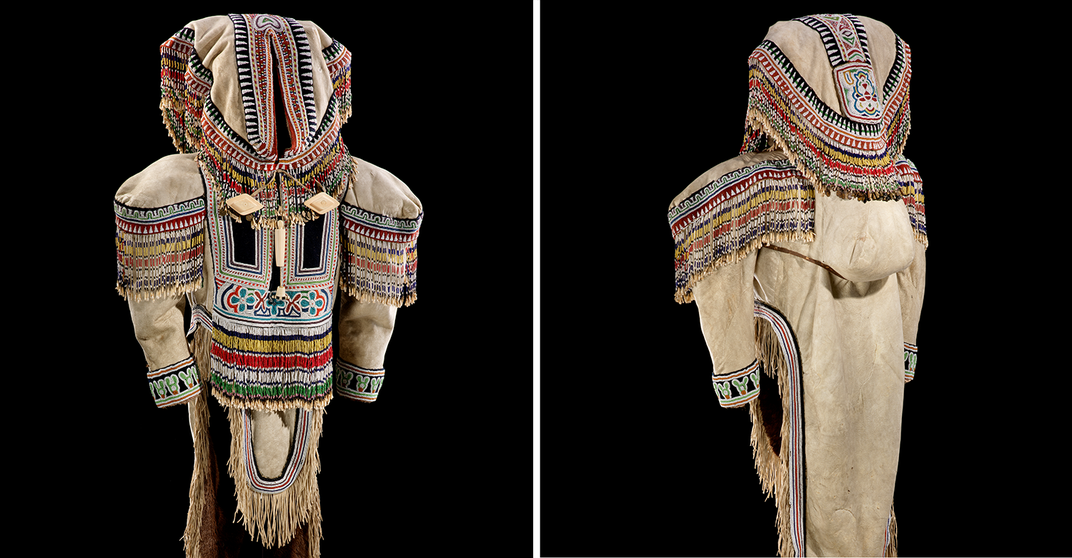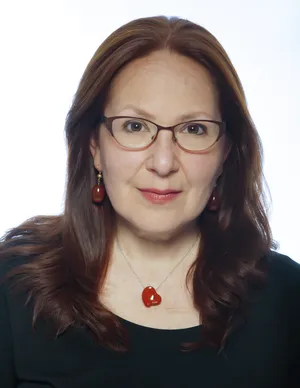NATIONAL MUSEUM OF THE AMERICAN INDIAN
Inuit Women’s Survival Skills, Which Kept Arctic Explorers Alive, Help Heal Residential School Survivors
This May the National Museum of the American Indian was privileged to host four remarkable Inuit women from Nunavut who were in Washington as guests of the Embassy of Canada to attend the opening of the exhibition “Captain George Comer and the Inuit of Hudson Bay.” At a related symposium, Bernadette Dean, Rosie Kowna Oolooyuk, Manitok Thompson, and Veronica Connelly spoke of the knowledge of land, ocean, ice, sky, and animal behavior their people shared with George Comer, a whaler who wintered over at Cape Fullerton 14 times in the early 1900s. They also described the knowledge Inuit women needed to make life-saving caribou and sealskin clothing. Now they’re concerned with passing that knowledge on, to help museums conserve Inuit collections and to help Inuit women heal from the deep-rooted scars left from attending Indian Residential Schools.
:focal(726x252:727x253)/https://tf-cmsv2-smithsonianmag-media.s3.amazonaws.com/blogging/featured/Inuit_visit_blog_women.png)
On May 4, the National Museum of the American Indian’s Cultural Resources Center was privileged to host a delegation of four remarkable Inuit women from Nunavut—Bernadette Dean, Rosie Kowna Oolooyuk, Manitok Thompson, and Veronica Connelly. All are highly skilled caribou and sealskin clothing makers and were in Washington, D.C., as guests of the Embassy of Canada to attend the opening reception for the exhibition Captain George Comer and the Inuit of Hudson Bay. Denis Chouinard, the embassy’s public affairs counselor, was responsible for this outstanding act of cultural diplomacy. It involved inviting the Inuit women not only to attend the exhibition’s opening, but also to speak at the symposium that preceded the opening and to visit the collections of historic Inuit clothing housed by the Smithsonian’s National Museum of Natural History, as well as in the Cultural Resources Center.
Presented in the embassy’s gallery, Captain George Comer and the Inuit of Hudson Bay was organized by the Mystic Seaport Museum in partnership with the embassy and the Canadian Museum of History. Fred Calabretta, Mystic Seaport Museum curator of collections and oral historian, as well as the exhibition’s curator, and John Moses, Canadian Museum of History repatriation supervisor, were also symposium panelists, as was Bernadette Driscoll Engelstad, a research collaborator with Natural History’s Arctic Studies Center. Stephen Loring, an Arctic archaeologist on the staff of the Arctic Studies Center, organized and moderated the symposium.
Captain Comer was a Quebec-born, New England–raised whaler who wintered over at Cape Fullerton, a whaling outpost on the west coast of Hudson Bay, 14 times in the early 1900s. Survival in the Canadian Arctic required the proper clothing, and Captain Comer was able to survive his winters at Cape Fullerton because of the caribou parkas, boots, mitts, and sleeping bags, as well as the sealskin boots (kamiit), that Inuit women made for him and his crew. While wintering over at Cape Fullerton, Comer recorded his observations of Inuit life. American Museum of Natural History anthropologist Franz Boas, Comer’s mentor in this endeavor, published major research papers based his fieldwork. The exhibition presents materials collected by Comer and, through them and contemporaneous photographs, explores late-19th- and early-20th-century Inuit life along Hudson Bay, as well as Comer’s relations with the Inuit. The exhibition will be on display through July 20, 2018.
Bernadette Dean has a family connection with Comer. American whalers such as Comer depended on Inuit people to know exactly when, where, and even how to hunt whales in the Arctic. Bernadette’s great-grandmother’s first husband, Ben Auqqajaa, helped Comer hunt whale, and her great-grandmother, known as Shoofly, made clothing for him. On one occasion Ben Auqqajaa saved Comer’s life, and a deep bond was forged between the Inuit couple and Comer. Bernadette first learned of her family’s connection to Comer during an interview with the whaling era historian Dorothy Harley Eber. Ms. Eber showed her mother an old photograph of a woman wearing a distinctively beaded caribou hide parka. Bernadette’s mother softy said, "Anaanattiara. My grandmother.” This was the first time Bernadette had seen anything related to her family’s history. Sadly Bernadette’s mother soon passed away, but with this family knowledge and photograph, Bernadette embarked on a life-long quest to find her great-grandmother’s parka and to study traditional Inuit clothing housed in museum collections.
Though quite remarkable, the relations forged between Bernadette’s great-grandmother, her first husband, and Comer were not rare. At the symposium, Manitok Thompson spoke of her family’s ties to a member of the 1878–1880 overland expedition from northwest Hudson’s Bay to King William’s Land led by Lt. Frederick Schwatka. Bernadette Dean, Rosie Kowna Oolooyuk, Manitok Thompson, and Veronica Connelly are well aware that non-Inuit could never have survived in the Arctic, one of the most forbidding environments on earth, without the knowledge their ancestors had gained over thousands of years of the land, ocean, ice, and sky, and of animal behaviors. Nor could Inuit people have survived without the knowledge their female ancestors needed to possess in order to make life-saving caribou and sealskin clothing. As Bernadette rightly asserted at the symposium, caribou fur is the warmest natural material available in the north from which to make clothing. Due to the caribou’s hollow hair, the time at which Inuit harvest caribou, and the manner in which Inuit women fashion it into clothing, it is extremely warm. The sealskin clothing Inuit women make is waterproof.
Bernadette Dean, Rosie Kowna Oolooyuk, Manitok Thompson, and Veronica Connelly are all fluent Inuktitut-speakers and knowledge keepers who are determined to preserve Inuit culture and traditions. They are all especially concerned with passing on traditional Inuit clothing-making skills. As the embassy’s Denis Chouinard understood quite well, their visits to view the Smithsonian’s collections would be profoundly important for them. In preparation, Stephen Loring and Bernadette Driscoll Engelstad came to the Cultural Resources Center a week ahead of time to identify specific articles of clothing that the women would most appreciate seeing and would want to examine carefully. On the morning of the visit itself, staff conservator Kelly McHugh and I laid out the clothing Stephen and Bernadette had identified on large tables.
We both had a special interest in facilitating this visit. Kelly was responsible for carrying out conservation treatments on clothing from Alaska’s Arctic region that both Natural History and the American Indian Museum have on loan to the Anchorage Museum, so that it can be available for hands-on study by Alaska Native elders, artists, and scholars. Kelly consulted closely with elders experienced in working with, for example, gut parkas and undertaking their repair. Though not surprised, she was deeply impressed with their expertise. I collaborated with Bernadette Dean, Bernadette Driscoll Engelstad, and Stephen Loring on the exhibition Infinity of Nations: Art and History in the Collections of the National Museum of the American Indian. Currently on view at the museum in New York, Infinity of Nations highlights an exquisitely beaded Inuit amauti or tuilli (woman’s parka) similar to the one worn by Bernadette Dean’s great-grandmother, Shoofly. It too dates to the height of the whaling period and was collected in present-day Nunavut at Chesterfield Inlet, not far from Cape Fullerton. Along with Bernadette Engelstad and Stephen, I spent a remarkable week listening to Bernadette Dean discuss the incredible practicality and beauty of the parka. Tuilli, as Bernadette explained, are specially designed inner parkas made to carry a baby. The mother needn’t take the baby out of the parka to nurse. The design’s broad shoulders allow the mother to shift the baby from the carrying pouch in the back, over her shoulder, to her breast while keeping the baby protected from the harsh Arctic weather in the warmth of her parka.

While at the Cultural Resources Center, the Inuit women, accompanied by Denis Chouinard, Fred Calabretta, John Moses, Bernadette Driscoll Engelstad, and Stephen Loring, examined several pairs of kamik (boots), pouches, sewing kits, and caribou and sealskin parkas made for men, women, and children, among other items. Clearly thrilled to see the clothing, the four Inuit women were also profoundly moved by what they saw. They regarded their ancestors’ clothing-making skills with deep respect. As far as they are concerned, those skills not only sustained Inuit for thousands of years, but can continue to do so far into the future.
Since 2003 Bernadette Dean has been running a women’s wellness program called Somebody’s Daughter. The program, as Bernadette explained at the embassy symposium, organizes workshops in the Kivalliq region of Nunavut in which Inuit elders teach young women all of the traditional activities associated with making caribou and sealskin clothing as a means to help the women heal from deep-rooted scars left from attending Indian Residential Schools. Established during an era of extreme paternalism, Indian Residential Schools removed Native children from their families and communities with the intention of severing all possible connections to their Native cultures and forcing their assimilation into mainstream society. Somebody’s Daughter workshops are held annually and last about two weeks. They are taught out on the land, away from community distractions, so that young Inuit women can concentrate on learning traditional knowledge, values, practices, and skills, and in so doing heal the negative impacts of residential schooling. Young women often take the workshops repeatedly. Last year, according to Bernadette, more than 230 women from all over Nunavut signed up for the program. As Bernadette explained with a quiet but unmistakable sense of urgency, “We don’t give up. Like the elders, we do our part.”

